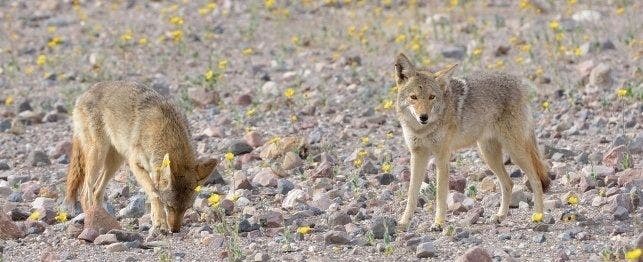
Coyotes in Our Neighborhoods: Their Impact on Dogs and Cats
When I was growing up in Central Ohio, I heard coyotes howling every week… on TV Westerns, that is. I’m pretty sure it was the same coyote recording for all the different shows.
Things have changed in the past few decades. I now hear coyotes howling on my own property, and I have heard coyotes kill fawns and rabbits not far from my back porch. Coyotes are now seen in towns and cities in broad daylight, much to the consternation of their neighbors. National Geographic estimates that the coyote population is at an all-time high, and coyotes have now been spotted nationwide.
This can mean danger for domestic animals, as coyotes are known to pursue them in the search for a meal. A Southern California study of coyote scat (fecal matter) found that the coyotes subsisted largely on dogs and cats in the winter and spring. They had learned to eat feral cat colonies that well-meaning rescuers had established and continued to eat the food regularly placed at the feeding stations.
The danger isn’t limited to pets, either. In early 2015, a man in New Jersey was attacked in his own yard by a rabid coyote. Attacks on humans are uncommon but have risen in numbers in the past 40 years.
Here in my own Central Ohio town, people have watched in horror as their pets were grabbed and dragged off into the woods by coyotes. One school even cancelled outdoor recess due to a daily coyote sighting. I saw what a coyote did to a West Highland White Terrier that belonged to a client; the dog was inside his invisibly fenced yard when the predator grabbed him and ran off. The dog’s owner gave chase and recovered his dog, but the poor animal was literally covered from head to toe in puncture wounds and had significant blood loss. He eventually died despite aggressive veterinary treatment. Cats are generally killed outright and carried off without a trace, leaving their owners to wonder where they went.
What Are Coyotes?
The coyote is a canid of North America, a smaller cousin of the wolf. Described as predatory, versatile, and adaptable, coyotes came about in the Mid-Pleistocene Era, 1 to 2 million years ago. Opportunistic hunters, coyotes eat rodents, birds, fish, rabbits, invertebrates, fruit, vegetables and more. Their predators include man, gray wolves, and cougars. (The reintroduction of red wolves to the Yellowstone area has reduced coyote numbers there.) Coyotes do mate with grey wolves and dogs on occasion, the progeny being known as coywolves or coydogs.
Coyote fur includes shades of brown, tan, and grey and frequently blends into the landscape, making them stealthy and effective hunters. They carry their tails down (wolves and dogs normally carry their tails level), and coyote tracks are more elongated than those of dogs. They are 1.5 to 2 feet tall, 41 to 53 inches long, and weigh from 20 to 50 pounds, the males being larger. They can have 3 to 12 pups in their spring and summer litters. Their social structure typically consists of nuclear families (with one male, one female, and several offspring) or loose-knit groups of pairings and pups. They are most active from dawn to dusk but are often nocturnal to avoid human contact. Their jaws can exert 300 pounds of pressure and they can run 40 miles per hour. Their usual gait is a ground-eating trot.
How Did Coyotes Get to Our Communities?
The coyote’s original habitat range included what is now the southwestern and plains areas of the US and northern Mexico, and the first historical recorded observance of coyotes was in 1750 by a priest near Kaskaskia, Illinois. (Lewis and Clark encountered coyotes on their journeys.) The eastern coyote (larger than its western cousin and is thought to be more of a coyote-wolf cross) appeared in New England and eastern Canada in the 1930s as the Eastern and Labrador wolves were killed off by man.
Throughout the last century, coyotes have begun moving into residential areas as their natural habitats are destroyed and developed. Displaced by human occupation and in need of resources to live, many coyotes have braved human contact and begun entering human neighborhoods. It is worth noting that coyotes are not native to many areas, including Ohio; they came to the Midwest area around 1919, when gray wolves and cougars had nearly been expunged by humans. Coyotes were shy then and kept to the remote areas. Well into the 1970s, citizens still believed that they were a creature of the West, not the Midwest, and certainly not Ohio.